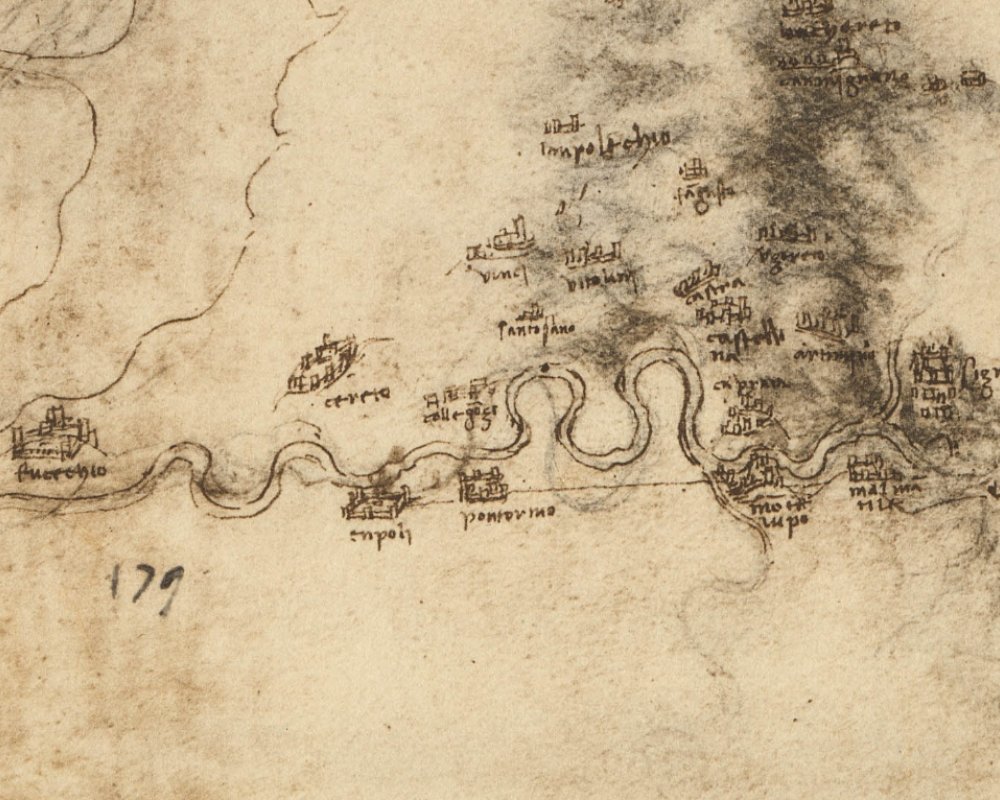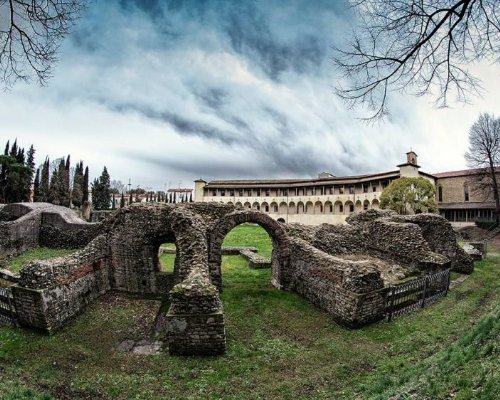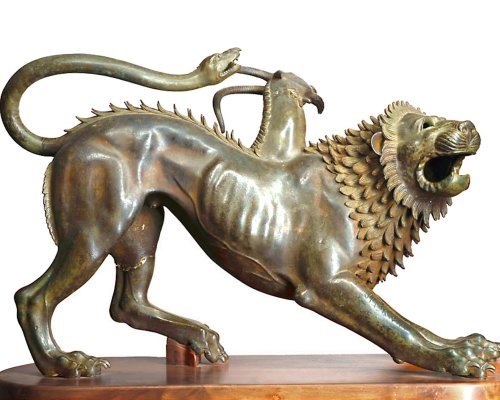In the footsteps of genius
Born in Vinci, land of the Etruscans, Leonardo was an impassioned learner about all things to do with Tuscan archaeology. His masterworks often contain references to antiquity. For example, in the Battle of Anghiari, the Genius’ “unlucky” painting, which was left incomplete and destroyed to make room for Vasari’s decorations, there were depictions that resembled Roman sarcophagi. Leonardo was very fascinated by the past and adopted ancient models in architecture as well.
Val di Chiana (both its Sienese and Arezzo sections), Prato, the Florentine hills, the Chianti area, the Terre di Siena and the Maremma are just a few of the regions that, through their vast patrimony, inspired the greatest scientist of all time.
Leonardo studied the archaeological past of Arezzo. The city, which has ancient origins, conserved unique archaeological relics, such as a Roman amphitheatre, set up in the monastery of San Bernardo and today part of the Gaio Cilnio Mecenate National Archaeological Museum. Additionally, numerous Etruscan relics came to light here, such as the Chimera, restored by Benvenuto Cellini. In the Museo Archeologico di Arezzo you can admire Hellenistic, Etruscan and Roman relics from all over the territory, which influenced Donatello and Verrocchio, along with Leonardo himself. Last but not least, the State Museum of Medieval and Modern Art holds a marble putto by Pierino da Vinci, Leonardo’s nephew.
From Arezzo, we move to Cortona, in the Val di Chiana Aretina. The village of Etruscan origin is home to the Biblioteca Etrusca, which holds a copy of the 17th century Libro di Pittura: “Opinione di Leonardo da Vinci. Modo di dipingere prospettive, ombre, lontananze, altezze, basezze da vicino, da lontano, et altro”. Before leaving, we’ll indulge in a break in a small downtown winery to taste a glass of the local wine, which was already beloved in Leonardo’s time.
The next stop is Chiusi, in the Sienese region of the Val di Chiana. In this area, which has been extremely important since the Etruscan era, Leonardo had the chance to study the tomb of King Porsena, present in the Atlantic Codex.
Leonardo studied the archaeological past of Arezzo. The city, which has ancient origins, conserved unique archaeological relics, such as a Roman amphitheatre, set up in the monastery of San Bernardo and today part of the Gaio Cilnio Mecenate National Archaeological Museum. Additionally, numerous Etruscan relics came to light here, such as the Chimera, restored by Benvenuto Cellini. In the Museo Archeologico di Arezzo you can admire Hellenistic, Etruscan and Roman relics from all over the territory, which influenced Donatello and Verrocchio, along with Leonardo himself. Last but not least, the State Museum of Medieval and Modern Art holds a marble putto by Pierino da Vinci, Leonardo’s nephew.
From Arezzo, we move to Cortona, in the Val di Chiana Aretina. The village of Etruscan origin is home to the Biblioteca Etrusca, which holds a copy of the 17th century Libro di Pittura: “Opinione di Leonardo da Vinci. Modo di dipingere prospettive, ombre, lontananze, altezze, basezze da vicino, da lontano, et altro”. Before leaving, we’ll indulge in a break in a small downtown winery to taste a glass of the local wine, which was already beloved in Leonardo’s time.
The next stop is Chiusi, in the Sienese region of the Val di Chiana. In this area, which has been extremely important since the Etruscan era, Leonardo had the chance to study the tomb of King Porsena, present in the Atlantic Codex.
The second day, our journey begins in Artimino, where we find the magnificent Villa Medicea La Ferdinanda. Here, in the heart of Montalbano, still today we can see a rustic spit roast, created according to Leonardo’s design.
In the Museo Archeologico you’ll find numerous relics of the Roman age; one section, however, is entirely dedicated to ceramics from Bacchereto, the village where Leonardo’s family had a kiln.
From the Valle dell’Arno we move toward Fiesole, on the outskirts of Florence. Leonardo probably admired the walls and the “Lago di Fiesole” in this Etruscan-Roman city; he likely drew these hills in the 20v sheet of the Madrid II codex. Fiesole is a romantic and fascinating city and merits a visit for its archaeological area, which includes a Roman theatre, spas, a temple and an archaeological museum.
The second day, our journey begins in Artimino, where we find the magnificent Villa Medicea La Ferdinanda. Here, in the heart of Montalbano, still today we can see a rustic spit roast, created according to Leonardo’s design.
In the Museo Archeologico you’ll find numerous relics of the Roman age; one section, however, is entirely dedicated to ceramics from Bacchereto, the village where Leonardo’s family had a kiln.
From the Valle dell’Arno we move toward Fiesole, on the outskirts of Florence. Leonardo probably admired the walls and the “Lago di Fiesole” in this Etruscan-Roman city; he likely drew these hills in the 20v sheet of the Madrid II codex. Fiesole is a romantic and fascinating city and merits a visit for its archaeological area, which includes a Roman theatre, spas, a temple and an archaeological museum.
From Fiesole, we move to explore the Chianti area, stopping in Castellina. Leonardo drew (among other subjects) a hypogeum mound, a type of funerary complex, discovered in this town. In Castellina in Chianti you can visit the Rocca, headquarters of the Museo Archeologico del Chianti Senese, which holds relics found in the surrounding towns of Castelnuovo Berardenga, Gaiole in Chianti and Radda in Chianti.
One room of the museum is dedicated to in-depth exploration of the Necropoli del Poggino and the Tumulo di Montecalvario. It’s likely that the latter was a source of artistic inspiration for Leonardo.
In his writings, Leonardo cites a centuries-old settlement in the south of Siena, referring to the Vescovado di Murlo. Murlo, a quintessential Etruscan town, is home to the Museo “Antiquarium di Poggio Civitate”, an archaeological area where numerous relics of the princely dwelling were discovered.
From Fiesole, we move to explore the Chianti area, stopping in Castellina. Leonardo drew (among other subjects) a hypogeum mound, a type of funerary complex, discovered in this town. In Castellina in Chianti you can visit the Rocca, headquarters of the Museo Archeologico del Chianti Senese, which holds relics found in the surrounding towns of Castelnuovo Berardenga, Gaiole in Chianti and Radda in Chianti.
One room of the museum is dedicated to in-depth exploration of the Necropoli del Poggino and the Tumulo di Montecalvario. It’s likely that the latter was a source of artistic inspiration for Leonardo.
In his writings, Leonardo cites a centuries-old settlement in the south of Siena, referring to the Vescovado di Murlo. Murlo, a quintessential Etruscan town, is home to the Museo “Antiquarium di Poggio Civitate”, an archaeological area where numerous relics of the princely dwelling were discovered.
The Etruscan Coast is one of the most famous destinations in Tuscany. Even Leonardo was fascinated by this area, so that in his writings he cites the coast and the promontory of Populonia, the only Etruscan city by the sea. Nowadays, the Baratti and Populonia Archaeological Park cherishes the remains of Fufluna, the only Etruscan town founded on the Tuscan coast.
If we move from the coast to the Maremma hinterland, we find other villages with Etruscan origins where time seems to have stood still. Sorano, for example, is a picturesque village in southern Tuscany hanging from a tufa stone and perfectly preserved over the years. Leonardo portrayed the Etruscan center of Sovana (a hamlet of Sorano) in particular he drew the “via del Cavone” (one of the pathways carved into the tuff hills by the Etruscans) the rupestrian necropolis and the tombs of Ildebranda and the Sirena.
The Etruscan Coast is one of the most famous destinations in Tuscany. Even Leonardo was fascinated by this area, so that in his writings he cites the coast and the promontory of Populonia, the only Etruscan city by the sea. Nowadays, the Baratti and Populonia Archaeological Park cherishes the remains of Fufluna, the only Etruscan town founded on the Tuscan coast.
If we move from the coast to the Maremma hinterland, we find other villages with Etruscan origins where time seems to have stood still. Sorano, for example, is a picturesque village in southern Tuscany hanging from a tufa stone and perfectly preserved over the years. Leonardo portrayed the Etruscan center of Sovana (a hamlet of Sorano) in particular he drew the “via del Cavone” (one of the pathways carved into the tuff hills by the Etruscans) the rupestrian necropolis and the tombs of Ildebranda and the Sirena.


